If you’ve ever wanted to speak at a National Council of Teachers of Mathematics (NCTM) conference or you’ve applied and were not accepted, then this blog post is for you. It’s the text version of a presentation called How to Apply and Speak at an NCTM Conference which Dan Meyer and I co-presented at the 2017 NCTM Annual Conference in San Antonio on April 6, 2017.
NCTM filmed the talk and broadcast it on Facebook Live. You can watch it below.
The image below shows you how we broke down the talk. I talked about how to apply and Dan shared about how to present. Unfortunately we didn’t have enough time to talk about everything, so our blog posts will have more detail. You can read Dan’s blog post on his site.
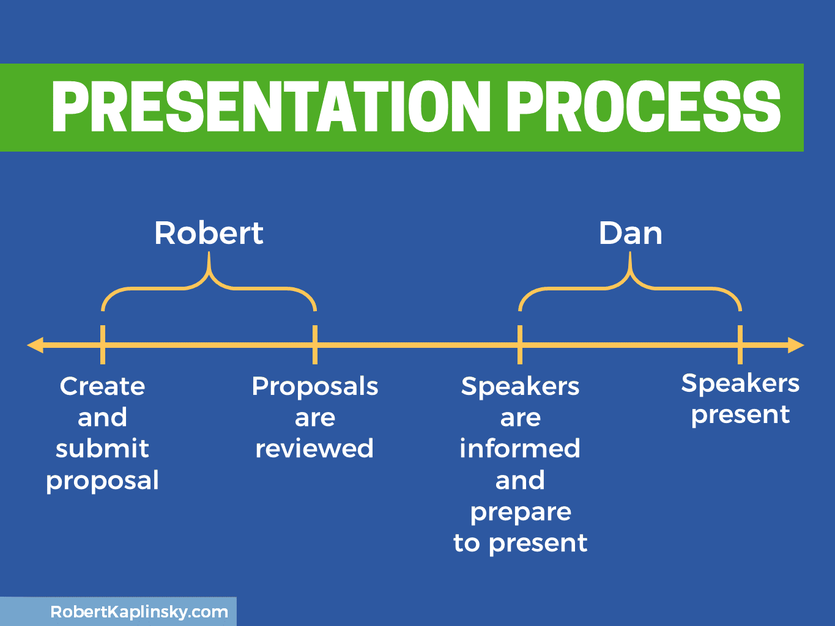
To get an idea of what people were interested in, we surveyed teachers to see what questions they had about applying and presenting at an NCTM conference.
.@robertkaplinsky and I are giving a talk called "How to Apply and Present at @NCTM." What questions can we answer?https://t.co/OPsqwR4Vqm
— Dan Meyer (@ddmeyer) February 9, 2017
One of the most common questions we received about applying was on whether NCTM uses a rubric to evaluate proposals and how to use that information to create a proposal that is more likely to be accepted:
“Are you planning on deriving some formula for the proposal process?”
“It seems like an arbitrary process. Is there a rubric that NCTM uses?”
“How do I write proposals so as to game the NCTM rubric system?”
So, to structure this blog post, I’ll share the rubric NCTM uses to evaluate proposals and then break it down section by section so you can write a proposal which is more likely to be accepted. I’ll mix in other questions we received as well as tips and lessons learned from people who have reviewed proposals.
Here’s a screenshot of the rubric NCTM used for the 2017 NCTM Regional Conferences in Orlando and Chicago and will continue to be using to evaluate proposals for the 2018 NCTM Annual Conference in Washington DC. You can download a PDF version of the rubric from the NCTM site.
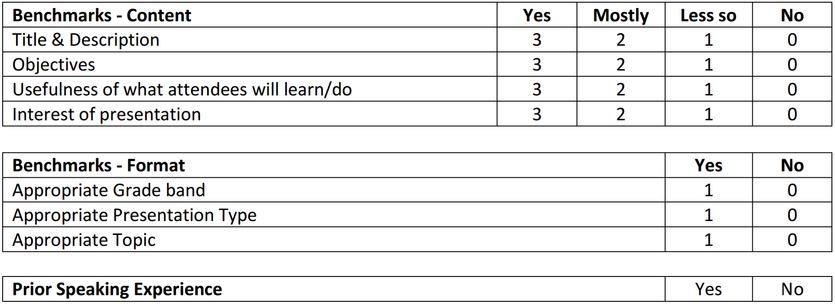
Realize that it is inevitable that this rubric will evolve over time. So, always seek out the latest rubric to make sure you know how your proposal will be evaluated.
Now that you know how your proposal will be evaluated, it’s time to decide on what you want to present on. You may already have an idea as to what you want to talk about. If not, ask yourself the question: “What am I doing that others might find useful?”
Additionally, here is some advice from Tracy Zager and Graham Fletcher.
“Don’t worry about ‘hot topics.’ Submitting a proposal on the latest fad lands you in a pile of similar sounding proposals.” — Tracy Zager
“I was surprised to see that only a handful of proposals intended to tackle math pedagogy or teaching practice in the 3-5 strand. The majority were content-focused and very few of them addressed measurement and data or geometry. This left an overwhelming number of proposals that focused on fractions. The lack of variety made reviewing extremely tough.” — Graham Fletcher
Now that you know what you want to talk about, it’s time to begin the proposal. In this section, I’ll break down three seemingly simple components that are too often overlooked. Those are: grade bands, presentation type, and strands.
Below is the rubric used to evaluate grade bands.
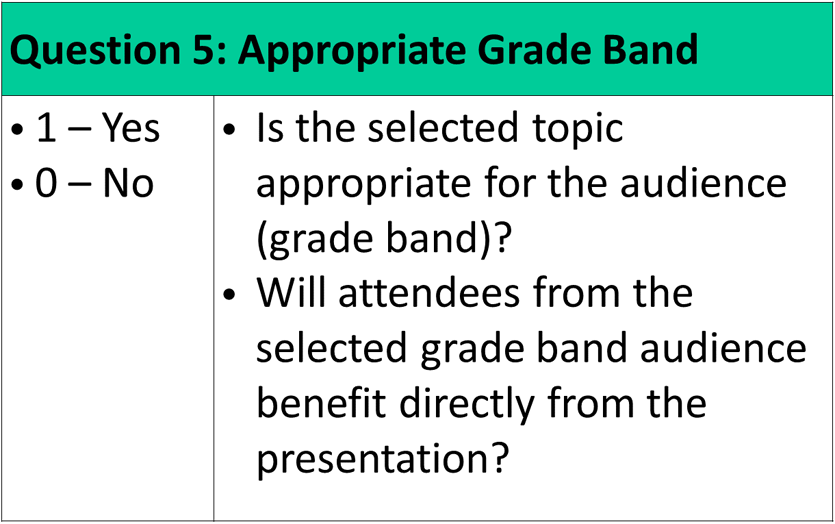
Here’s a pop quiz! Which of these 5 sessions will likely get rejected?
- PreK-2 session on ratios
- 3-5 session on fractions
- 6-8 session on functions
- 8-10 session on quadratics
- General interest session on decimal operations
Keep reading for the answer.
Here is more advice from program committee members Christina Tondevold and Tracy Zager.
“The main thing I looked at first and foremost was to see if the content was even related to the grade level. For instance if your session is talking about ratios but you submitted it to PreK-2, it pretty much doesn’t have a shot. Even though there are definitely things that we can be doing in PreK-2 that help build the understanding needed for ratios when they get to 6th-8th grade, that isn’t the main concern of PreK-2 teachers.” — Christina Tondevold
“Don’t choose general interest if it isn’t really general interest. General Interest sessions are defined as having ‘issues of interest to multiple grades and audiences.’ They should either share specific content from multiple grade bands or tackle broader issues in our profession.” — Tracy Zager
So, based on the comments from Christina and Tracy, both the PreK-2 session and the General Interest sessions have an uphill battle to be accepted. The PreK-2 session’s content is not appropriate for the grade level and the General Interest’s session is not broad enough.
Here’s another pop quiz! Which grade bands are the most competitive?
- PreK-2
- 3-5
- 6-8
- 8-10
- 10-12
- General interest
Make your guess and check out the chart below. It shows the acceptance rate based on the number of accepted proposals divided by the total number of proposals submitted for all of the 2016 and 2017 NCTM Annual and Regional conferences.
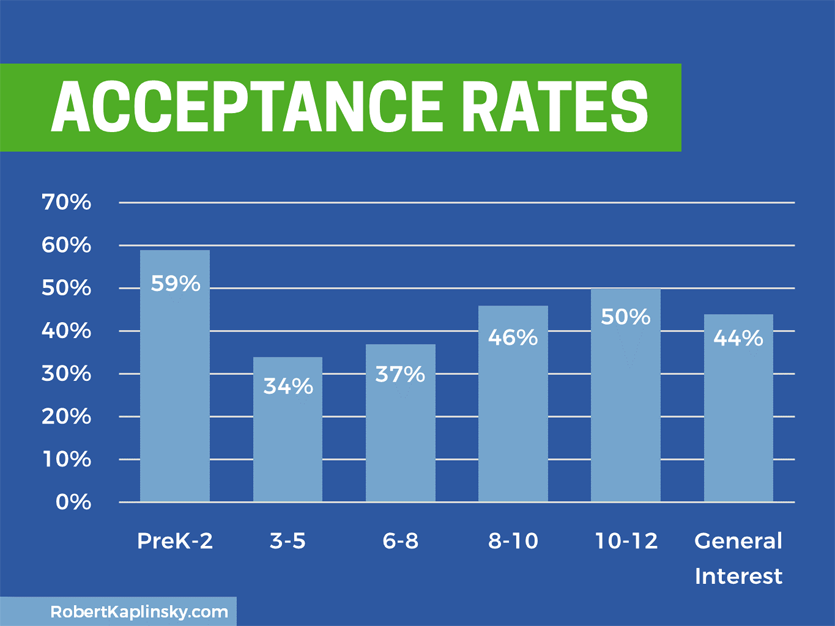
At a glance, it is easy to see that 3-5 and 6-8 are the most competitive. The inference to make here then is that if you have a choice of grade bands, choose a less competitive grade band. For example, if you wanted to present about using Number Talks in elementary school, it would make more sense to use PreK-2 content over 3-5 content.
Another important note is that very, very few people apply for the Higher Education and Research grade bands. In fact, there are often fewer people applying than there are slots to fill! So, if you can at all qualify for one of those two grade bands, you should have a great chance if your application meets the minimum requirements.
Below is the rubric used to evaluate presentation type.
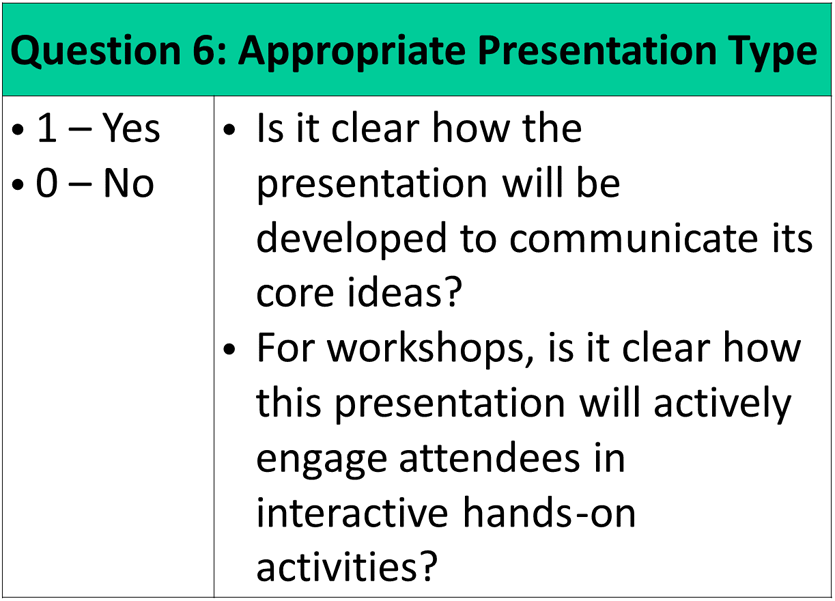
There are three types of presentations at NCTM conferences:
- Burst (30 minute lecture-style presentations with auditorium seating)
- Session (60 minute lecture-style presentations with auditorium seating)
- Workshop (75 minute interactive presentations with tables and chairs)
Here’s another pop quiz! Which of these presentation types are less competitive?
- Burst
- Session
- Workshop
Make your guess and check out the chart below. It shows the acceptance rate based on the number of accepted proposals divided by the total number of proposals submitted for all of the 2016 NCTM Regional conferences and 2017 NCTM Annual and Regional conferences.
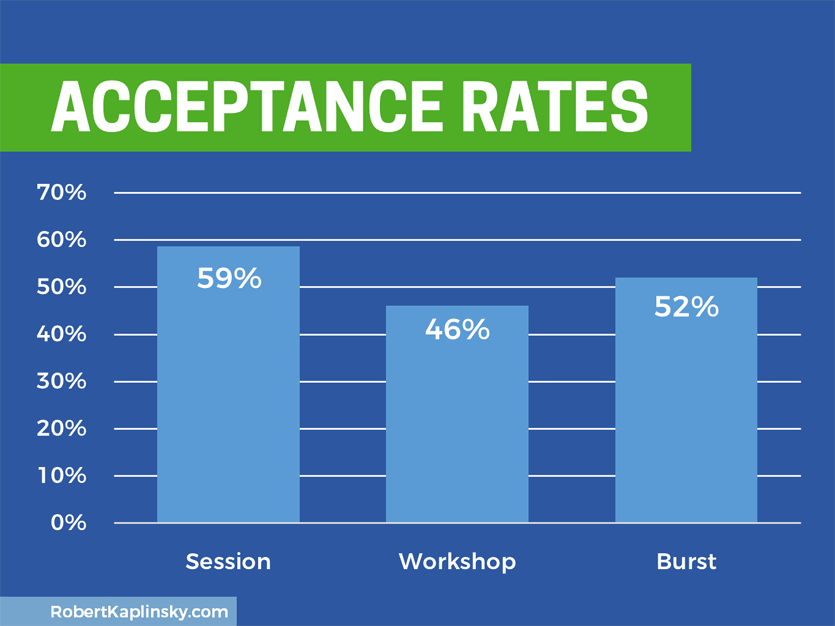
The takeaway from looking at this graph is that workshops are more competitive so you should consider apply for sessions and bursts. That might be a bit misleading because while fewer people apply for Burst presentations, there are also far fewer slots available than there are for sessions and workshops.
Each NCTM conference creates strands which represents themes they hope to emphasize. You have to select the strand that your proposal fits in and it will be evaluated accordingly. You can find more information about the strands at NCTM (look for “strand titles and descriptions” on this page).
Below is the rubric used to evaluate whether your proposal fits in the selected strand.
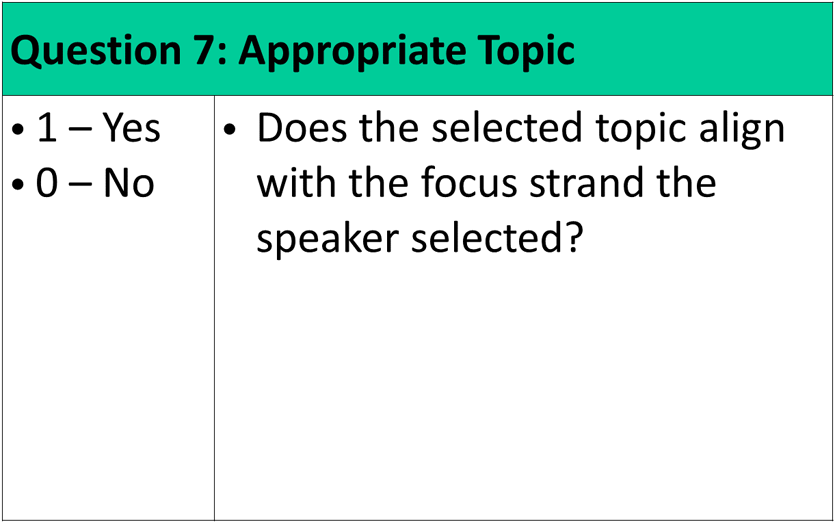
Here is more advice on picking strands from Thomasenia Lott Adams, the chair of the 2018 NCTM Annual Conference program committee, Andrew Stadel, a member of the 2017 NCTM Annual Conference program committee, and Nanette Johnson, a member of the 2017 NCTM Orlando Regional Conference program committee.
“Having experienced being rejected a few times over my 20+ years of being active in NCTM, after serving on a program committee, I realized how important it is to make sure that the message of my proposal is clear and aligned with the theme or a particular strand, because many others will be aiming for the same mark.” — Thomasenia Lott Adams
“Seek out the strand descriptions FIRST. Read, understand, and use them as a guideline. Make sure to read the strand descriptions so that you are sure you are submitting to the right one. Or, you might get disqualified.” — Andrew Stadel
“Choose the less popular strands. For example, if you are doing a proposal on using technology to assess students, you could pick the tech or assessment strands.” — Nanette Johnson
Make sure you take the time to read these strands. It’s an easy point to gain. Admittedly, Nanette’s advice is challenging to implement. So, make your best guess as to what is least popular and go with that.
Here’s another pop quiz! Which of these presentation types are less competitive?
- Burst
- Session
- Workshop
Make your guess and check out the chart below. It shows the acceptance rate based on the number of accepted proposals divided by the total number of proposals submitted for all of the 2016 NCTM Regional conferences and 2017 NCTM Annual and Regional conferences.
Next up are the Title and Description for your proposal. Both will appear in the program as typed and appropriate capitalization is expected. There is a 100-character limit for the title and 350-character limit for the description.
Below is the rubric used to evaluate your title and description. Note that you can earn up to 3 points in this section.
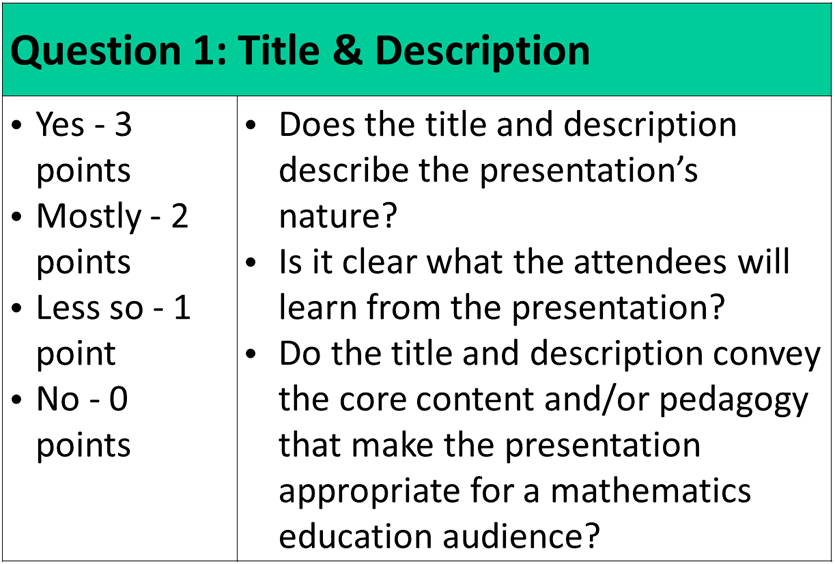
Here is advice from Mike Flynn and Andrew Stadel on crafting a title.
“Cutesy titles are not as original as people think. I know people want their sessions to stand out but I think I counted 6 different titles that used that same ‘Something, something, and something, Oh My!’ format.” — Mike Flynn
“Avoid excessive capitalization and/or punctuation.” — Andrew Stadel
Another common question we received about keywords and phrases NCTM may be looking for:
“What are the keywords/phrases that NCTM is looking for and how do I incorporate those into my proposal (and presentation)?”
I sent this question over to more program committee members including 2017 NCTM Orlando Regional Conference program chair Zak Champagne and 2017 NCTM Chicago Regional Conference program member Tracy Zager.
“I’m not sure that NCTM or any committee is looking for any specific keywords or phrases. If so, they certainly weren’t communicated to me. However, if I were to suggest any keywords or phrases, I’d suggest reading the descriptions of the strands and using some of that language. It certainly would show the reviewers that you were aware of the strands and carefully thought about how to match your session to that vision.” — Zak Champagne
“Talk about the idea, not the thing. I saw a whole bunch of proposals around the use of dominoes and dice games in K-2, but really, those sessions were about subitizing. Don’t sell me the app, or tape diagrams, or a specific manipulative. Sell me on the mathematical learning we’re going to be talking about, and then how we can use this tool to support it.” — Tracy Zager
Here’s another pop quiz! Which of these two descriptions is more likely to score well?
- Students develop deeper understandings when they build from concrete strategies to representational and abstract thinking. We will use manipulatives to demonstrate how you can help students build conceptual understanding in your classroom.
- This workshop will present hands-on activities and projects that use CRA strategies to inspire the challenged learner as well as challenge the inspired learner. Come ready to learn about using manipulatives to get students actively thinking about mathematics!
Read on to learn more.
Here are a few more tips from my own experiences on a program committee:
- Be specific
- If there isn’t enough space (because of character limits) in the description to talk about your presentation, make sure to explain it within the other questions.
- Avoid filler text
- Try not to use generic statements that don’t provide much clarity. For example, “Come ready to learn about the latest trends in mathematics that will help your student excel in all areas.” doesn’t go far to help someone figure out what the presentation will actually be about.
- Don’t assume
- Realize that people may not be familiar with the acronyms you use or the people you reference. What is obvious to you may be confusing to others and should be explained somewhere.
- Triple check your proposal
- Review your proposal’s content, grammar, and spelling before you submit. Spelling and grammar errors detract from the proposal’s overall quality. For example, if you’re doing a presentation on online learning and are spelling “Khan Academy” as “Kahn Academy,” it doesn’t reassure the reviewer that you are familiar with the content.
So, based on this information, the first description is more likely to score well than the second description. The second description is filled with generic filler text and uses an acronym (CRA = Concrete Representational Abstract) that may not make sense to the reviewer.
In addition to the questions you are asked that you see directly used in the program (such as name, presentation title, presentation description, grade band, etc.) there are always additional questions you have to answer. Your responses to these questions are not shared with attendees, but the program committee definitely uses your responses to determine whether your proposal should be accepted.
For the 2018 NCTM Annual Conference (and possibly beyond that), those questions include:
- Participant learning outcomes
- Focus of the presentation
- Alignment to NCTM’s equity & access position
- Table usage for workshops
Make no mistake about it, answering these questions well is often the difference between having your proposal accepted or rejected. You can earn up to three points for answering them well.
Here is the rubric that will be used:
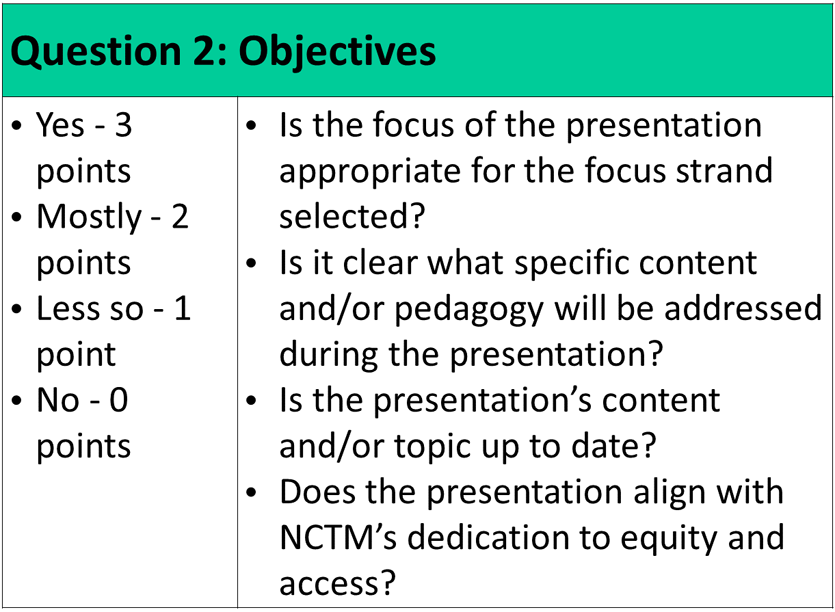
Here is some general advice from Tracy Zager and Mike Flynn:
“Think about the proposal as a whole more. I think most people start at the top and work their way down, taking each section to pretty close to completion before moving on to the next. What this means is there’s a perceptible drop off in thoughtfulness the farther down you go.” — Tracy Zager
“Organizing the flow of your session helps. Some people listed how long they’d spend on each topic and gave a sense of the flow. That gave me the impression that they really thought it out. Just don’t overdo it. I had one that said 17% of the time will be spent doing… And 49% of the time will be spent doing…” — Mike Flynn
One specific question we received about this category included:
“What are we supposed to write for questions like access and equity?”
Here’s another pop quiz! Which of these responses better demonstrates that “the presentation aligns with NCTM’s dedication to equity and access?”
- This session will be taught in a way that is equitable and accessible to all learners. All students will be able to benefit from the math in this session because it is at their grade level. The presentation slides will be accessible on my blog and student resources can be accessed on the internet.
- This session will show how teachers can expose students of all backgrounds to mathematics and computer science. Computer science is not simply a topic for boys who like to code, but rather a discipline that can be harnessed by all to explore mathematics at a deep level.
Read on to learn more.
Carl Oliver actually addresses this question thoroughly on his blog and he’s given me permission to share his advice. First, it’s important to know what NCTM’s Access and Equity position is. You can find it by searching for “nctm access and equity” on Google where it is the first search result taking you to this page on the NCTM website.
This position includes the statement:
“Addressing equity and access includes both ensuring that all students attain mathematics proficiency and increasing the numbers of students from all racial, ethnic, linguistic, gender, and socioeconomic groups who attain the highest levels of mathematics achievement.” — NCTM Position on Access and Equity
So, while the first response may be equitable in terms of access to resources and is grade level appropriate, the second response more adequately addresses NCTM’s official position.
Carl goes into great detail as to what a quality response looks like and candidly states:
“Proposals that fail to address NCTM’s statement in this section stick out like a sore thumb and those proposals are worrisome to reviewers.” — Carl Oliver
Another piece of additional information you’ll be asked for is about your prior speaking experience. Here’s what the rubric looks like:
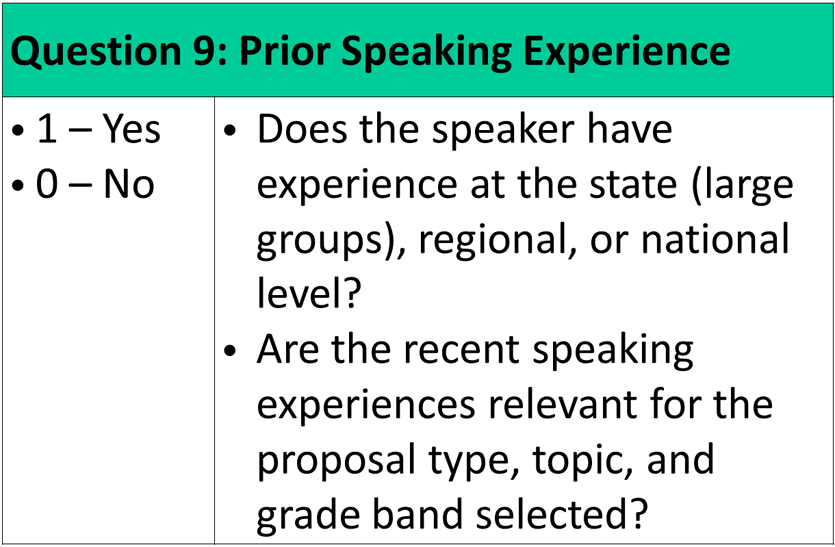
When answering these questions, keep it short and sweet. Reviewers are trying to quickly determine if you have relevant presentation experience. Putting lots of text makes that much harder. Don’t list papers you wrote or workshops you gave for your district. Just make it clear that this is not the first time you have ever presented at a large state, regional, or national conference.
If it is your first time presenting, seriously consider doing local or state level conferences before you apply for NCTM. It will give you valuable experience and make your proposal look much stronger. Having no speaking experience does not rule out a really good proposal but does make a borderline proposal seem less likely to be accepted.
One question we received from Henri Picciotto was:
“It is very difficult to know what will get accepted. For example, proposals involving the Lab Gear (a commercial product, alas) are sometimes accepted, sometimes rejected because of the reference to the commercial product.” — Henri Picciotto
Here’s the rubric reviewers use when evaluating your proposal:
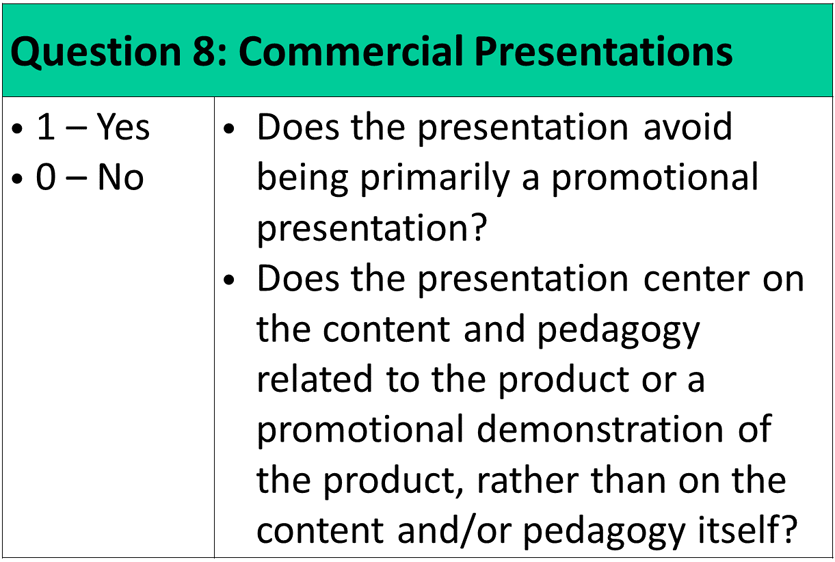
I can see how this would be confusing if you’re not a business. So, here’s a little more information to clear this up:
- Businesses doing infomercial style presentations about their products have to pay to present at an NCTM conference and are not allowed to use the traditional proposal submission process. If your proposals sound like it may be a commercial presentation, even if it is not, it may get rejected.
- If you mention using free resources like games or apps, make sure you state that they are free resources or it might look like you are doing a commercial presentation.
- If your organization is listed as a business and not a school district, it begins to look like it will be a commercial presentation. This is especially true when your presentation mentions that you will be using educational products and your company just happens to sell that product. If that isn’t the case, make it obvious.
The final two rubric categories are Usefulness and Interest of Presentation. They are actually two separate but similar categories that make up a total of six points or 37.5% of maximum score.
The rubrics for each category is listed below.
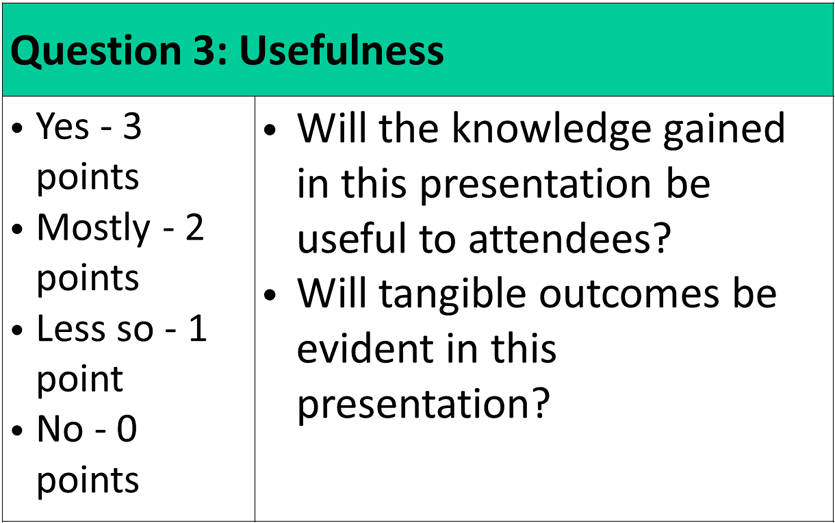
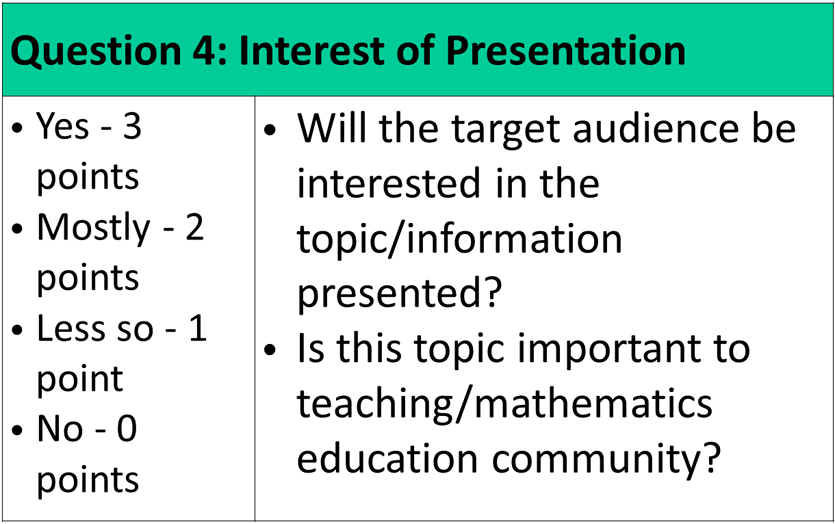
Unfortunately, this is going to be the hardest section for me to give advice on. What needs to stated is that there is significant variability in terms of how proposal reviewers will score.
Each reviewer comes with his or her own experiences, preferences, and biases. What may be useful and interesting to you and your community may not resonate as much with someone else reading your proposal. Perhaps this isn’t what you want to read, but it’s the truth.
What this means for you is that it is up to you to explain your passion. Why is your presentation content so immensely useful? Why will people be interested in learning about it? Don’t make any assumptions here and state anything that can support your position.
We’re now done with the rubric, but there are a few more questions that people asked which I want to address.
“Do reviewers see your name when you submit a proposal? What about evaluation or attendance data?”
I sent this question over 2017 NCTM Annual Conference program chair Sarah Bush and she stated:
“During the proposal review process, all identifying speaker information is hidden so that proposals are reviewed by blind peer-review.” — Sarah Bush
To be clear, this means that the your name is not shown to the person reviewing your proposal. This is intended to make the review process more equitable. Additionally, for better or worse, information such as your evaluations or the number of people in your room is not provided to reviewers.
Examples of why not having access to evaluation or attendance data is good include:
- you may have had a bad time slot/location and had few people attend
- you were sick and didn’t do your best and got bad evaluations.
Examples of why not having access to evaluation or attendance data is bad include:
- people who may be popular may not be accepted because they didn’t write a good proposal.
- this makes it hard to figure out who writes a good proposal but doesn’t have a well received presentation.
Another question we received was:
“If I had to cancel my session ahead of time, will that prevent me from being accepted?”
Sarah Bush responded to this question as well and stated that:
“Canceling ahead of time does not at all prevent you from being accepted to present at a future conference.” — Sarah Bush
The final question we received was:
“Why did my proposal get accepted at one NCTM conference but when I submitted the same proposal it didn’t get accepted at any others?”
It’s hard to know exactly why this happened as there are many possible reasons. Those include:
- The topic you submitted to one conference may have been less popular than at another. So, if you were the only submitted presentation on building conceptual understanding of standard deviation at one conference but were competing against several others at the other conferences, that obviously plays a part.
- The reviewers have their own biases that make them more or less interested in what you have to say.
- The strands for each conference are not identical so if your proposal doesn’t adjust accordingly, that will be problematic.
This was a really long post and I hope you found it useful. Our hope has been to open up the process to make it more transparent and equitable. Please let us know in the comments if you have any questions that weren’t answered or any thoughts that stand out. Thanks.

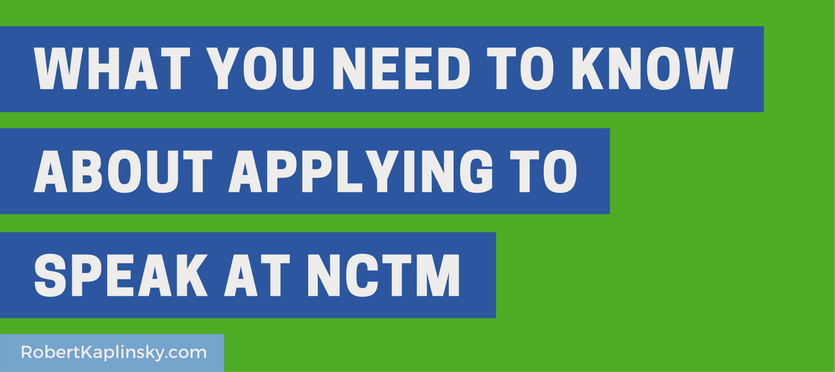
Super helpful! I can’t wait to share with teachers at my school who may be interested in presenting next year (since we’re just a few miles from D.C.!)
One thing I wish is that there was a K-5 band for presentations that aren’t just K-2 or 3-5 but aren’t really general interest in the sense that they have an elementary focus.
Hi Kassia. Interestingly they changed 6-8 and 9-12 to 6-8, 8-10, and 10-12. However, K-5 has been separated for as long as I have been doing this. I believe that the problem is that making a K-5 slot usually results in lots of 3-5 sessions and few for PreK-2 teachers.
This was such an insightful post, especially as I’m just starting the draft of my proposal. It feels like I have ‘the inside scoop’…thank you! One question: is there a limit to how many proposals you can submit? TIA!
Great question Lynn. I reached out to NCTM and was told: “For the Annual Meeting, lead speakers are only allowed one submission (the system will not allow more than that) and they may also be a co-speaker on up to two proposals. For the Regional Conferences, lead speakers are allowed to submit multiple submissions and there is no limit on how many sessions they can be a co-speaker on. “
Wow! That response was quicker than my kids getting ready for bed! LOL Thanks for the info!
Lynn, thanks for asking this question. I was in need of this answer myself! Robert, I just sat down to think through a session proposal for NCTM 2018 and read your post in preparation. I have been presenting at state, regional, and national NCTM conferences for over 25 years, and learned a great deal from your post. Thank you for taking the time to pull this information together in one place. I think you may single handedly increase the quality of session proposals this year.
Wow. That’s great to read. Clearly this was a team effort as I was pulling from Dan’s suggestion to even do this presentation as well as feedback from many other program committee members. Thanks for the kind words.
In regards to the post above, does that mean 3 in total? I can submit one as the lead (with others) and two as co-presenters (if I am not the lead)?
I believe your understanding is correct, Beth.
How about the financial requirements to speak? If you speak do you have to pay to NCTM anything? I know at some conferences if you speak there is no fee.
I believe that if you speak at an NCTM annual conference, you do not get any discount for speaking. It’s the exact same thing as normal. However, if you speak at an NCTM regional conference, you get free registration.
Obviously, this may change in the future but I believe this to be true currently.
Really great advice!
Thanks Jon. Dan and I are trying to support NCTM and its members.
What grade band should you choose if your target audience are Math coaches? Would that fall more under “General Interest?” We work primarily with grades 7-12 Teachers. Thank you!
Hi Cassie. It looks like I forgot to include the complete list on my blog post. I believe that there is a band for teacher leader and coaches so that would be a perfect fit.
Thanks, Robert! I appreciate your input!
So much good advice! Thank you! I may have a doh! question, And as I say there is no such thing as a dumb question, I will give myself permission to ask it: When you use the word, “strand,” as in, “focus strand selected,” are you talking about NCTM strands in general or a specific strand that is the emphasis for the conference?
Thanks again for such a thorough post!
Thanks for allowing me to clarify myself Amy. I am talking about the strand for the conference. Each conference’s program committee with sit down and discuss the main themes they want to emphasize at their conference. Those will wind up becoming the conference’s strands.
Now, I’m sure you won’t be surprised that there is a lot of overlap when it comes to the strands for current NCTM conferences and even with NCTM itself. For example, I would be shocked if technology, assessment, and equity were not strands everywhere in education. So, that could add to the confusion since you see so much of the same, everywhere you look.
Let me know if I missed anything.
Hi Robert – Thanks so much for doing all of this work and sharing it. We would really appreciate your advice… If your session is focused on bringing something from research into the grades K-3 classroom, would you recommend that we tag it as Research or PreK – 2? Thanks!
Hi Lori. This is an interesting question. If your only concern was simply getting accepted, I would recommend doing research if you are truly doing research. This is because they often have less research proposals submitted than slots to fill.
However, as I recall, the research conference happens before the main NCTM conference. I believe it is usually on Wednesday during the day before the opening session. So, if that is still the case, then while your proposal would be accepted, it wouldn’t be part of what you’d traditionally expect to be the main NCTM conference.
So, if that matters to you, then I would definitely do PreK-2. That is still much more likely to be accepted than a 3-5 session.
Lori, here’s a little more info on this from Thomasenia, who is the chair of the 2018 NCTM Annual Conference program committee: https://twitter.com/nleehansen/status/856165268879527936
Thanks Robert. I appreciate the help!
Thank you so much for creating this post! I was accepted to speak at NCTM on my first application a few years back. But have not had success on my last 2 proposals. This makes so much sense as I review my initial proposal and the last two. This was an awesome source of information!
Thanks Darlyne. I’m glad it helped peel back some of the layers that may be unclear. Hope you find more success!
Thanks for all of this Robert. I’m curious about “alternate lists.” Do you have any access to stats regarding how many proposals are placed on the alternate wait list, rather than just outright rejected, for the regional and/or annual conferences? Also, any stats about how many proposals placed on the alternate list wind up being accepted eventually? I am wondering if this is a common (and very understandable) hedging move on NCTM’s part, or more of a rare “You’re really, really close to being accepted!” acknowledgment of a near-miss. Thanks!
Hi Dave. I really don’t know. My hunch is that they wouldn’t do this for show, just to make people feel better.
FYI, I sent a message to some program chairs asking them about your question. Perhaps they’ll be able to provide some additional insight.
Hi Dave,
Robert’s right. It’s not for show. I don’t have access to any stats (and I long deleted any emails I sent as part of being on the San Francisco program committee, so I can’t pull any from there). The percent of proposals that are waitlisted depends on the “queue” (which is the combination of grade band and proposal type, e.g. “8-10 Workshop”). From memory, for larger queues, about 15 – 20% of the number of the accepted proposals are waitlisted. So, if 30 proposals were accepted, I submitted a ranked list of about five to the program chair. (That might be five of 40 or five of 75; again, it depends on the grade band/proposal type.) For smaller queues, this percent was much greater. For example, if there were to be two bursts at a particular grade level in the program, I submitted a waitlist of two. I can’t comment on how many of these waitlisted sessions actually wind up being in the program other than to say that they do. Some speakers — like me — submit in hopes that their district will help with travel expenses and release time. Speakers are submitting for the following school year, so this information may not yet be known. When speakers are notified, sometimes they cannot accept because they were unable to secure this funding/support (or because of any number of other reasons). This is where the waitlist plays an important (real) role.
Chris
Thanks for posting Robert!
Under the section “Focus on Math” I’m having a hard time deciding. My overall proposal is for all domains in the Pre-K-2 umbrella. Do I need to have a specific focus to boost my chances? Thanks,
John Silverthorne
I am only mostly sure about this, but I think that the purpose of that question is to make sure that there will be some math happening. So, I’d get into the specifics of the math you’ll be doing/sharing and not worry about sticking to a specific focus. That is what I believe.
Hi Robert, this was super helpful and extremely interesting. My student and I just had a proposal rejected so I’m reading this blog a few years late, LOL. Thank you for sharing. BTW, I was looking for acceptance rates for the annual NCTM conference and your blog popped up.
Glad you found it useful, Shelly. For what it’s worth, I’ve been rejected from the last two NCSM conferences, so it’s not always clear to me either.